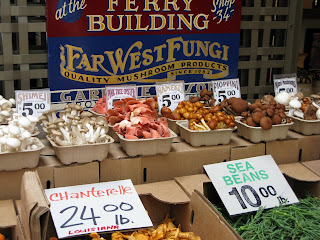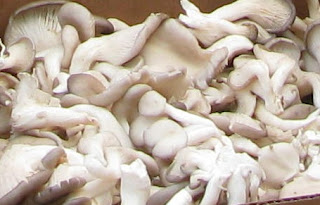 November 7, 2009
November 7, 2009Many years ago, when I was an undergraduate microbiology student at McGill University in Montreal (Canada), I took a mycology course given by the Botany Department. Unlike courses in clinical mycology that I have taken, the Botany Department course surveyed fungi that live and grow in fields and forests.
The professor marked our final lab session by preparing for us a dish of mushrooms sautéed with butter and sherry. Needless to say, we gave him an "A+" for his final grade.
Despite – or perhaps because of – having taken that course, I have never tried to pick wild mushrooms for the dinner table. There are too many poisonous varieties that resemble completely innocuous mushrooms.
Everyone is familiar with the typical cultivated mushrooms that are found, either loose or packaged, in the produce section of the local supermarket. These mushrooms were on display at the San Francisco Farmer's Market in September.

They can easily be confused with two very poisonous mushroom varieties – Amanita phalloides and Amanita ocreata – that, between them, were responsible for 894 episodes of poisoning in the state of California in 2008.
As I was reminded while roaming the Farmer's Market, edible mushrooms come in a surprising range of shapes, sizes and colors. There are chanterelles and cioppini, portobello and pioppini, lobster mushrooms and oyster mushrooms.
These are just some of the mushroom varieties that were on display at the market.
And here are a few more.
The lobster mushrooms and oyster mushrooms intrigued me most – not only due to their names, but because of their growth and development.
Oyster mushrooms come in a variety of sizes and colors. They grow wild on dead tree bark, and look for all the world like oyster clusters. They are also reputed to taste like oysters.
A lobster mushroom is the result of a parasitic fungus growing on certain species of mushrooms. The parasite changes the color, shape and texture of its host mushroom, producing a lobster mushroom.

With the amazing variety of mushrooms that are available at Farmer's Markets such as the one in San Francisco, who needs to forage for fungi in the field?







hello sir, i have a question about "auxin".... is the extraction of auxin from a plant possible? and can auxin help in the growth of mushrooms? thank u sir, i am hoping for an answer.... my e-mail address: renette_may@yahoo.com
ReplyDelete